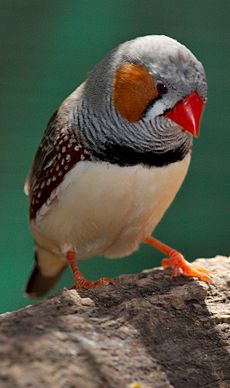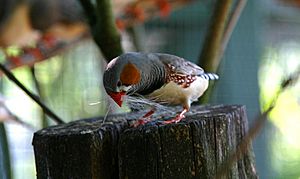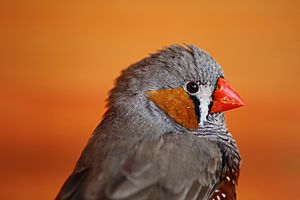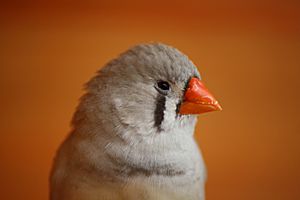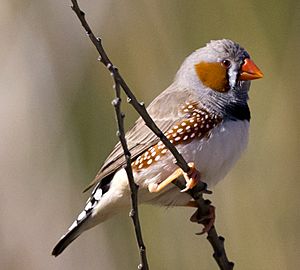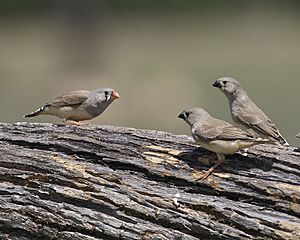Zebra finch facts for kids
The zebra finch (Taeniopygia guttata) is a small, common bird found mostly in Central Australia. It lives across most of the continent, but avoids very cold, wet areas and some parts of the tropical north. You can also find it naturally on Timor island. This bird has also been brought to places like Puerto Rico and Portugal.
Quick facts for kids Zebra finch |
|
|---|---|
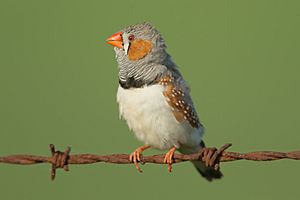 |
|
| Conservation status | |
| Scientific classification | |
| Genus: |
Taeniopygia
|
| Species: |
guttata
|
| Synonyms | |
|
Poephila guttata |
|
Contents
About the Zebra Finch
The zebra finch was first discovered in 1801 during an expedition to Australia. A scientist named Louis Jean Pierre Vieillot described it in 1817. He gave it the scientific name Fringilla guttata. Later, in 1837, another scientist, John Gould, described the Australian type of this bird. Its current group name, Taeniopygia, was given in 1862.
There are two main types, or subspecies, of the zebra finch:
- Taeniopygia guttata guttata: This type is called the Timor zebra finch. It lives on islands like Lombok in Indonesia and along the coasts of Australia.
- Taeniopygia guttata castanotis: This type is found across most of mainland Australia. It is sometimes called the Australian zebra finch.
Scientists believe the zebra finch first appeared in Australia. The way the Timor zebra finch is spread out today might be because of a past ice age. During that time, sea levels dropped, bringing Timor and Australia closer. This allowed birds to fly between the two places.
The two subspecies look a little different. The Timor zebra finch (T. g. guttata) is smaller. Also, the males of this type do not have the fine stripes on their throat and chest. Their chest bands are also smaller.
Where They Live
The zebra finch lives in about 75% of mainland Australia. This is the Taeniopygia guttata castanotis subspecies. It usually avoids the very edges of the coast, except for the dry western side. The T. g. guttata subspecies lives on islands like Lombok and Sumbawa. It also lives on other islands to the east and south of Indonesia.
Zebra finches usually live in dry areas. They like places close to water, especially where rain collects. However, this is more about having enough plants than just water itself. They live in grasslands with scattered trees and bushes. They also live in open or grassy woodlands. Sometimes, they are found in farm areas, like rice fields. On islands, they usually stay in low coastal areas. But they can move to higher places, up to 2,300 meters (7,500 feet), if there are more farms and grasslands.
Rainfall often starts their breeding season. But too much heavy rain can be bad for them. Their nests do not protect chicks or eggs from rain. Sometimes, they even leave their eggs if it rains too much. In some parts of northern Australia, these birds might move inland during the wet season. They return to coastal areas when it gets drier.
Life Cycle
How long a zebra finch lives can change a lot. This depends on their genes and where they live. In the wild, a zebra finch might live up to five years. If they are kept as pets in a cage, they usually live for 5 to 9 years. Some have lived as long as 12 years, and one even lived for 14.5 years. In the wild, the biggest dangers are predators like cats and not having enough natural food.
Song and Calls
Zebra finches are known for being loud and active singers. Their calls can sound like a loud beep, meep, oi!, or a-ha!. Males sing a rhythmic song that can be simple or complex. Each male's song is unique. However, birds from the same family will have similar songs. Young male finches learn their songs from older male birds. They have a special time when they learn best.
Young birds start with a "subsong," which is not very structured. This changes into a "plastic song." This song changes a lot, but it starts to sound like the tutor's song. Studies show that birds can learn a song after hearing it only a few times. They create a "template" of what their song should sound like. They use what they hear to learn and practice their song. Adult birds keep their songs by fixing any mistakes. By about 90 days old, their song becomes fixed and does not change anymore.
Only male zebra finches sing. Females do not. This is because of how their bodies develop. Male embryos produce a hormone called testosterone. This hormone helps their brain develop the parts needed for singing. Many parts of the brain work together to produce song. Scientists study zebra finches to understand how brains learn and remember. This research can even help us understand human speech. For example, a gene called FoxP2 is important for song learning in finches. This gene is also linked to speech problems in humans. The zebra finch was the second bird to have its entire genetic code mapped, in 2008.
Zebra finches also use special calls to talk to their eggs. If the weather is hot (above 26°C or 79°F) and the eggs are close to hatching, the parent bird makes an "incubation call." This call changes how the chicks grow and behave. Chicks that heard this call when it was hot weighed less when they left the nest. Chicks that did not hear the call weighed more in hot nests. Also, chicks that heard the call were more likely to make calls themselves when it was hot.
Zebra finches also use calls to decide who takes care of the babies. If a male bird is late returning to the nest, the calls between the parents become shorter and more frequent. This is the first time scientists have seen birds "negotiating" parental care with their voices.
Behaviour
Breeding
Zebra finches usually breed in groups, called colonies. These colonies can have up to 50 nests. Sometimes, they might nest alone. They often build their nests in thorny bushes or trees. They can also use other natural or man-made structures. It is common to find many nests in one bush.
In parts of Australia that are not dry, colonies are often used all year. On cold days when they are not breeding, the birds feed in large groups. Then they break into smaller groups to rest, clean their feathers, sing, and find mates. They feed again in a large group before returning to the colony before sunset. On warmer days, some small groups go back to the colony to build nests. During breeding season, birds building nests return after about an hour of feeding. On cold days, birds sitting on eggs or chicks join them.
Zebra finches often do not breed in the exact place they were born. This movement helps prevent too much inbreeding. Breeding in colonies helps protect nests from predators. Nests closer to the main colony are less likely to be attacked. If a nest is attacked, the pair might build a new nest further away. Birds are also more likely to nest near other finches. They might even choose to nest near others that have successfully raised chicks.
Zebra finches build two types of nests: one for sleeping (roosting) and one for breeding. The roosting nest is round with a large side entrance. It helps the birds stay warm. A bird in a roosting nest saves about 18% of the energy compared to one outside. The breeding nest is usually 12 to 24 cm (5 to 9 inches) long. It has a small entrance and a tunnel about 3 to 5 cm (1 to 2 inches) wide and up to 8 cm (3 inches) long. This tunnel hides the eggs. The egg chamber is inside, about 12 to 20 cm (5 to 8 inches) across. This chamber often sits on an old nest. The walls of the nest are 1 to 3 cm (0.4 to 1.2 inches) thick. The outside layer is made of stiff grass, and the inside is soft. The egg chamber is also lined with soft materials like wool and feathers. Both nests are protected during the day. But the breeding nest is always guarded.
The zebra finch is an opportunistic breeder. This means they start breeding about one to three months after water becomes available. This timing helps make sure young birds hatch when there are plenty of seeds to eat. In captivity, they can breed all year if they have enough water. They are socially monogamous, meaning a pair stays together until one bird dies. If one dies, the other will find a new partner.
They lay between two and eight eggs in a clutch, but five is most common. The eggs are white or pale grey-blue. They are about 16 by 10 mm (0.6 by 0.4 inches) in size. The eggs hatch after 14 to 16 days. Sometimes, other zebra finches lay their eggs in another pair's nest. This is called brood parasitism. This happens in about 5% to 11% of offspring. Females can sometimes tell their own eggs apart by smell.
Young zebra finches leave the nest about 17 to 18 days after hatching. They start feeding themselves around 35 days old. However, they still depend on their parents socially until they are 36 to 50 days old. During this time, males and females also start to look different. These finches become ready to breed quickly. Most try to find a partner and breed when they are about 80 days old.
Males and females are similar in size. But it is easy to tell them apart once they are grown. Males usually have bright orange cheek feathers and red beaks. Females have orange beaks. Males also have more striking black and white patterns.
Inbreeding
Inbreeding (when closely related birds breed) can cause young zebra finches to die early. This is called inbreeding depression. It does not seem to affect how many eggs they lay. Embryos from related parents have a much lower chance of survival. For example, a study found that only about 25% of eggs from sibling pairs survived. This is compared to about 41% for unrelated pairs.
Diet
Zebra finches mainly eat grass seeds. They prefer seeds that are partly ripe or fully ripe. They also eat dry seeds. They remove the husks from the seeds. They find seeds on plant stems and on the ground. The grasses they eat usually have seeds between 1 and 2.6 mm (0.04 and 0.1 inches) long. They prefer larger seeds that are easy to de-husk. They also eat insects, mostly ants and termites. They catch these insects during short flights from a perch. They also eat flowers from plants like Chenopodium. Young chicks eat mostly half-ripe and ripe seeds, plus green plant material. Grass seeds are their main food because they are common and easy to find in their dry climate.
Zebra finches usually look for seeds on the ground. They pick up seeds one by one. They also eat seeds directly from standing grass. To do this, they might fly up and peck out seeds. Or they might perch on a nearby branch. They can also pull a grass head to the ground with their beak or feet. When food is scarce, they can dig into the ground to find buried seeds. They prefer patches of seeds that have fewer husks and are larger and denser.
These birds often look for food in groups, called flocks. Sometimes, they forage in pairs or alone. During breeding season, small or medium-sized flocks are common. But when not breeding, flocks can have up to 500 birds. They sometimes join flocks with other types of finches. Birds that arrive later at a feeding flock might take food from others. Birds that arrive early are more likely to find food for themselves.
Zebra finches feed most actively in the first hour after sunrise and the second to last hour before sunset. When there is less food, they spend more time feeding in the afternoon. They also spend less time at each food patch before moving on.
Drinking and Bathing
A zebra finch usually drinks about 24% to 28% of its body weight in water each day. This is about 3 mL (0.1 fluid ounces) at a temperature of 22 to 23°C (72 to 73°F). When it is hotter, around 40°C (104°F), they might drink 6 to 12 mL (0.2 to 0.4 fluid ounces) of water daily. They also get water from seeds and from their body breaking down food. This "metabolic water" can be enough when temperatures are below 23°C (73°F). Zebra finches can survive periods with little water. One study found that birds could survive on just 0.5 to 1 mL (0.02 to 0.03 fluid ounces) of water per week for several months. More than half of the birds in another study survived for 513 days with no water at all.
When water is nearby, zebra finches drink regularly throughout the day. If water is far away (over 5 km or 3 miles), they usually drink most around midday. They prefer to drink from small puddles or other water collections. They especially like those with gently sloped edges. They also prefer open drinking areas. They can even drink dew from the tips of leaves. Because of predators, zebra finches gather in a bush or tree near a waterhole. They only go to drink when the group is large enough. They drink for only a few seconds. After drinking, they usually bathe for about a minute. Then, they dry off and preen their feathers in a warm, safe spot.
The zebra finch can drink 1.5 mL (0.05 fluid ounces) of water in just 3.6 seconds. They do this by swallowing water while their beak is still in the water. Most birds lift their beak to swallow. The zebra finch's tongue scoops water into its throat. Then, the front of its voice box pushes the water into its food pipe. This method helps them drink faster. It also lets them drink from more places, like dew drops or cattle troughs. They can even drink upside down from troughs.
Temperature Regulation
A zebra finch's body temperature can range from 38 to 44°C (100 to 111°F). It goes up when the air temperature rises. Body temperatures over 45°C (113°F) can cause death within an hour. To cool down, they first cover their feathers with water. They also stay still and hold their wings out. This exposes areas with fewer feathers to the air. They can also cool down a lot by losing water through their lungs and skin. They start panting when their body temperature reaches 42 to 43°C (108 to 109°F). This can happen when the air temperature is as low as 32°C (90°F). Panting can cause them to lose too much water and become tired.
Zebra finches have a simple system of blood vessels in their head. This means they cannot cool their brain as well as some other birds. This, combined with losing too much water, can cause many birds to die during long periods of high temperatures. For example, in January 1932, temperatures in northern Southern Australia were between 47 and 52°C (117 and 126°F) for 16 days. This caused tens of thousands of zebra finches to die. Many were found in dams.
Predators
Animals that eat zebra finch nests include the tiger snake, brown snake, dragon lizard, pygmy mulga monitor, singing honeyeater, grey-crowned babbler, yellow-throated miner, little crow, Torresian crow, black rat, and house mouse. Meat-eating marsupials also eat nests. Barn owls catch adult zebra finches when they are sleeping.
Images for kids
See also
 In Spanish: Taeniopygia para niños
In Spanish: Taeniopygia para niños



